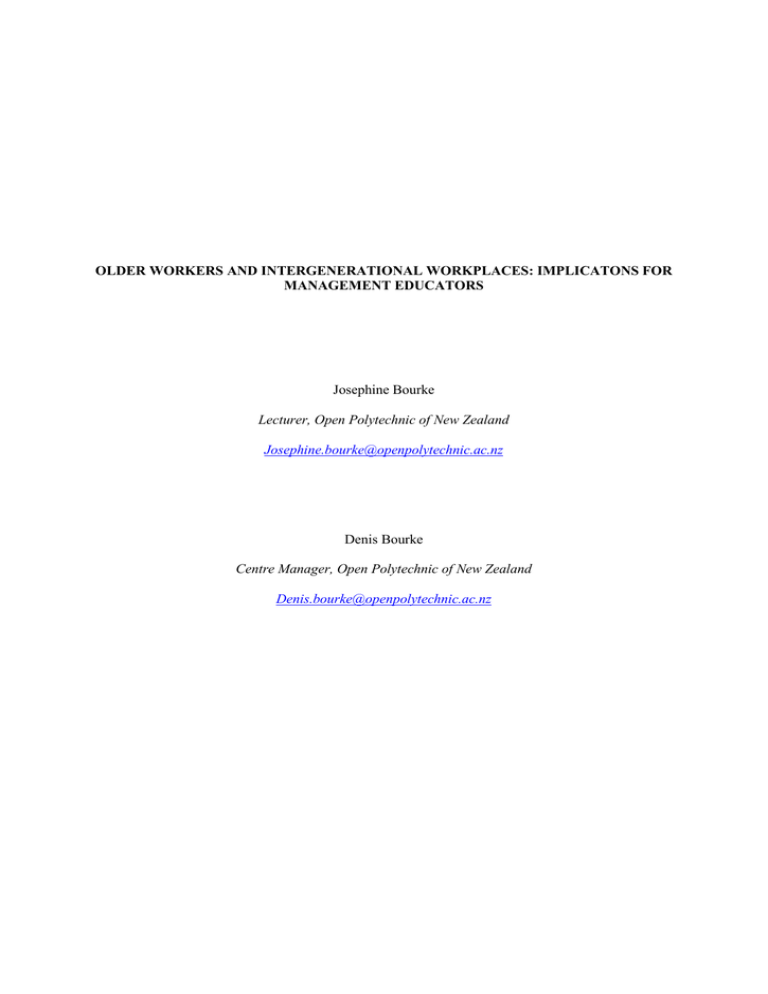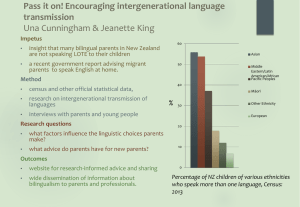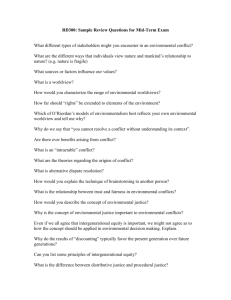OLDER WORKERS AND INTERGENERATIONAL WORKPLACES: IMPLICATONS FOR MANAGEMENT EDUCATORS Josephine Bourke
advertisement

OLDER WORKERS AND INTERGENERATIONAL WORKPLACES: IMPLICATONS FOR MANAGEMENT EDUCATORS Josephine Bourke Lecturer, Open Polytechnic of New Zealand Josephine.bourke@openpolytechnic.ac.nz Denis Bourke Centre Manager, Open Polytechnic of New Zealand Denis.bourke@openpolytechnic.ac.nz OLDER WORKERS AND INTERGENERATIONAL WORKPLACES: IMPLICATIONS FOR MANAGEMENT EDUCATORS Increased workforce participation by older workers is an emerging reality. Older workers are often perceived as reluctant learners unable to adapt to new technology, but both research and empirical evidence suggest that this stereotyping is not valid. Where managers hold to this view they create the reality of aged-based cohorting by denying older workers training in technology, which in turn leads to reduced technological skills. Consequently, older workers will be denied positions where technology skills are important. Yet, as producers and consumers, older workers can only remain valuable economic contributors if managers better understand how to encourage them to change and (re)train. The limiting factors in developing workers are attitude and aptitude, not age. Discrimination on age-related grounds can distract the debate from the real management issues around maintaining a competent workforce. Training and development in the workplace is about developing workforce skills. Managers cannot expect optimal performance in a changing workplace unless investment is made in developing workers hand-in-hand with investment in technologies. Stigmatising a worker cohort on the basis of age is counter-productive to this process. This paper reports an analysis made of relevant New Zealand Diploma in Business courses to establish the extent to which learners are introduced to management of intergenerational workplace issues. The conclusion reached is that no learning outcomes address these issues, and raises the question of whether management educators are permitted sufficient flexibility to introduce emerging workplace issues in this programme. Keywords: Management, older workers, technology. Introduction Stereotypical attitudes exist across generations (Desmette & Gaillard, 2008; Erber & Long, 2006). These stereotypes have fostered an environment which values a youthful workforce, and accordingly there is a tendency to “…downgrade and discourage older workers…” (Patrickson & Hartmann, 1995). Many workers experience ageism in the workplace (Davey & Davies, 2006), despite this being illegal under New Zealand legislation (Department of Labour, 2009a). There is further evidence of stereotypical cohorting of older workers as a group that is generally resistant to change (Alpass & Mortimer, 2007; Department of Labour, 2001; Gray & McGregor, 2003; Knight, 2006). It seems often presumed that this resistance is purely a product of age, yet every older worker, at one stage, was a younger worker. 2 The findings of research undertaken by Goodmeasure Inc., an international consulting firm based in Boston, Massachusetts, were distilled into ten common factors which cause resistance to change, but none of these factors provide evidence that workers resist change simply on the basis of their age (Kanter, 1985). The factors that might contribute to the perceived resistance in workers are loss of control, loss of face, concerns for future competence, and past resentments that previous change did not deliver the intended benefit to the workplace nor the personal reward that was promised (Daft & Marcic, 2009; Devos, Buelens, & Bouckenooghe, 2007; Labianca, Gray, & Brass, 2000). Perhaps it is more of a matter of ‘...here we go again, another bunch of consultants telling us we’ve got it wrong, who will raise a lot of dust and then disappear, leaving us to clear up’. There is a paradox apparent in the attitude displayed by managers towards older workers. On the one hand, despite professing to value their experience, reliability and loyalty (Loretto & White, 2006), many managers appear reluctant to hire older workers (Guest & Shacklock, 2005; Loretto & White, 2006; Patrickson & Hartmann, 1995). On the other hand, because of the perceptions that older workers are reluctant to change, managers fail to respect them or acknowledge their skills (ArmstrongStassen, 2008; Davey & Davies, 2006). Perhaps this paradox is explained by the fact that over the last twenty years there has been a focus on downsizing workforces, and policies adopted have deliberately encouraged older workers to exit the workforce (Armstrong-Stassen, 2008). Currently demographic forecasts are driving debate on the sustainability and affordability of pensions, with some claiming that the baby boomers are robbing the next generation. Various solutions such as charging surtax on baby boomers to support their own generation, increasing the pension entitlement age, and reducing pension incomes have been suggested. Any of these alternatives will force older workers to remain in the workforce for years beyond previously accepted retirement ages. Older workers will therefore comprise an increasing factor in workforce intergenerational diversity into the future (Armstrong-Stassen, 2008; Davey & Davies, 2006; Guest & Shacklock, 2005; Pillay, Kelly, & Tones, 2010; Statistics New Zealand, 2010). 3 At present, there is no general agreement on the when a person becomes an older worker (Claes & Heymans, 2008). However, a consensus is forming that people aged over 50 are more generally regarded as ‘older workers’ (Department of Labour, 2009b; Dixon, 2009; Loretto & White, 2006; Morrow & McElroy, 1987). It is concerning that the outcome of this consensus might be that “…from the moment they are categorized as “older workers”, individuals become potential targets for prejudice…related to ageing…”. (Desmette & Gaillard, 2008). If such prejudice is permitted to persist, then managers will either ignore, or fail to recognise, the huge resource in knowledge and skill possessed by the older-worker cohort. Given the reality of an ageing workforce, it is essential for managers to acquire the knowledge and skills to balance the expectations of an inter-generational workforce. Management educators in turn need to introduce discussion on intergenerational issues into their teaching curriculums. While there is growing understanding of the dynamics involved in intergenerational workplaces, the concerns and expectations of each generation cohort must be carefully managed. The New Zealand Diploma in Business (NZDipBus) is designed to provide learners with opportunities to gain a broad range of business knowledge and skills1. The qualification includes an option to specialise in studying management, but little within the courses offered can claim to address the emerging management problem of the intergenerational workforce. It is time for educators to consider introducing learners to this emerging issue and for the NZDipBus to incorporate an intergenerational aspect into its prescriptions for management studies. METHODOLOGY The prescriptions for NZDipBus management-related courses were examined to determine to what extent, if any, they currently address intergenerational workforce issues. Four courses within the NZDipBus programme were identified as addressing the management discipline, and therefore logical vehicles for including discussion about intergenerational workplace issues. The four courses were: 530 Organisation and Management 1 Information from www.nzqa.govt.nz 4 630 Leadership 633 Human Resource Management 635 Employment Relations Each course prescription was analysed to determine if any of the Learning Outcomes addressed agerelated workforce diversity. Version 2 of the NZDipBus no longer includes teaching notes or lists of recommended resources such as textbooks in its published prescriptions. Therefore, a selection of well-known textbooks which are relevant to the four courses was reviewed, to determine if they in turn contained any discussion on intergenerational workplace issues. RESULTS AND DISCUSSION The analysis of the course prescriptions highlighted sections within the required learning outcomes which could be expected to include discussion on intergenerational workplace issues. The sections identified addressed workplace environment and organisational culture, leadership, change management, and various aspects of managing people in organisations. Table 1 summarises the sections of the learning outcomes in each of the four courses dealing with the management topics likely to address age-related workplace issues. Course 530 Organisational and Management Learning Outcome 3 (Environments – including organisational culture) 8 (Leadership, motivation and delegation) 630 Leadership 1 (Leadership) 2 (Culture and leadership) 4 (Applying leadership to change) 633 Human Resource Management 1 (Relationship of HRM to organisation) 3 (Recruitment and Selection) 5 (Performance management) 7 (Legislative requirements) 635 Employment Relations 1 (Key factors) 2 (The employment relationship) Table 1: Management topics considered relevant to intergenerational workplace issues. 5 Having identified logical areas in the prescriptions for the four courses where these issues could be raised, the analysis found nothing in the learning outcome wording that gave any hint that intergenerational workplace issues need to be discussed. Attention was then turned to the well-known textbooks that had been identified as typical of the resources used by educators teaching the four courses. The textbook review indicated that for the course 530 Organisation and Management a typical textbook might be “Understanding Management” by Daft & Macic (2009). This is a dynamic and interesting text, which introduces management learners to a wide variety of current issues, including environmental, diversity, innovative and ethical goals (Daft & Marcic, 2009). This book introduces the concept of intergenerational diversity, but it does not elaborate on the requirements of managing older workers. The general thrust of its discussion appears little more than the statement that “…generational diversity is a powerful force in today’s workplace, with employees of all ages working together…”(Daft & Marcic, 2009, p. 20). For the course 630 Leadership a suitable text to support learners is “Leadership” by Dubrin, Dalglish and Miller (2006). This text includes much that would be useful to managers seeking to improve their skills in managing diversity and understanding change. Change is covered in Chapter 14, where issues around organisational change are looked at in some detail, emphasising the importance of leadership in managing change (Dubrin, Dalglish, & Miller, 2006). The text also devotes Chapter 15 to managing for diversity, stating that “…valuing diversity (should be) embedded in organisational strategy…” (Dubrin, et al., 2006, p. 443). However the emphasis of the chapter is clearly aimed at cultural differences with no discussion on the intergenerational workforce. 633 Human Resource Management might typically use “Human Resource Management in New Zealand” by Rudman (2010). There are several points at which discussion could be expanded to include intergenerational issues. However, no specific study of older workers as a group is offered. Critical human resources challenges facing managers outlined in the book include “…managing demographics — adapting to a shifting age structure and the resulting loss in productivity and capacity…” (p.30) “… The labour force aged 65 and over will rise …to…about 200,000 from the 6 mid-2030s…” (Rudman, 2010, p. 33) and similar age-demographic observations can be found elsewhere in the text. Nevertheless, the general tone in the book of dealing with an ageing workforce seems to be one of encouraging retirement. Chapter 26 for example goes into detail on redundancy, retirement, and preparation for retirement. Even though it is acknowledged that in a previous era “…many competent people were forced to retire on reaching retirement age to leave jobs in which they were still performing and contributing well,,,” (p. 332) the reader is then told that people are encouraged “… to retire before the ‘normal’ retiring age as a way to reduce staff numbers or clear succession or promotion blockages…” (p. 333). The text book selected as suitable for 635 Employment Relations is “Employment Relations in New Zealand” by Rasmussen (2009). This book is largely focussed on the structure and process of employment relations as managed in New Zealand, with coverage of relevant legislation, bargaining and negotiation. The text refers to equal employment opportunities, an area which would be of importance to older workers. There is information on flexibility and labour market models which might be relevant to workplace diversity (Rasmussen, 2009). It also covers the area of age discrimination as part of the overall discussion of discrimination in the employment relationship, and introduces the learners to the increasing participation of older workers, indicating that “…Continuing discrimination on the basis of age and the demographic trend towards an older population and labour force make the issue of age an important one…” (Rasmussen, 2009, p. 221). It is reasonable to conclude at this juncture that current textbooks are beginning to address the emerging issue of the ageing workforce, but the prescriptions for the NZDipBus have not yet recognised the need for this learning. There are three areas which are logical points for introducing inter-generational awareness in management education, being: 1. Motivation 2. Staff Training 3. Change Management 7 Motivation Motivation is an area which should include the concerns of older workers. According to studies conducted by Claes and Heymans (2008), the motivational variables that drive employee attitudes change over a working lifetime. If employees are to be equally valued by their organisations then understanding the motivations behind older worker performance will be beneficial to management (Claes & Heymans, 2008). Staff Training A general perception persists that older workers are difficult to train, are unable to cope with technology (Gray & McGregor, 2003), or do not want to take part in training (Claes & Heymans, 2008). Interestingly, mentoring and coaching of junior staff is a function often undertaken by older workers (Rudman, 2010). Australian data shows that people aged between 55 and 64 (older workers) are the fastest growing users of information technology (Australian Human Rights Commission, 2010). Furthermore, the Committee for Economic Development in its study New Opportunities for Older Workers (1999) found that appropriate training provided in a supportive environment can greatly assist older workers to learn new technology systems (Australian Human Rights Commission, 2010). However, if managers hold what is an erroneous discriminatory view, then older workers will be denied the training opportunities necessary to fully engage in the future workforce. Change Management The stereotyping of older workers as reluctant to change ignores the fact that older workers have encountered an employment environment which has changed significantly since they began their careers. The earlier clarity and reciprocity around employment relationships has become faded (Ng & Feldman, 2008). Managers need to understand that any change needs to be well led, well communicated, and inspired (Kotter, 2006) and provide people with an opportunity for control and choice (Chua & Iyengar, 2006). This is particularly true in situations where employees are likely to have experienced loss of trust previously, as they will need more encouragement to embrace current change successfully (Devos, et al., 2007). 8 Recommendations The NZDipBus, has a stated purpose of providing learners with opportunities to gain a broad range of business knowledge and skills. If this is to be fully met, then the learning outcomes should provide opportunities for discussion of intergenerational workforce issues. Table 2 identifies the points at which information about and discussion of intergenerational diversity could be introduced into the learning outcomes of the selected courses.. Course 530 Organisational and Management Learning Outcome 3 (Environments – including organisational culture) 8 (Leadership, motivation and delegation) Suggested inclusion 3 (Workplace age-diversity) 630 Leadership 1 (Leadership) 2 (Culture and leadership) 4 (Applying leadership to change) 1 (Leadership and older workers) 2 (Organisational culture including age) 4 (Leading older workers through change) 633 Human Resource Management 1 (Relationship of HRM to organisation) 3 (Recruitment and Selection) 5 (Performance management) 7 (Legislative requirements) 1 (HRM and intergenerational workforces) 1 (Key factors) 1 (Understanding employment relationships in intergenerational workplaces) 2 (The employment relationship with diverse workforces) 635 Employment Relations 2 (The employment relationship) 8 (Motivating intergenerational employees – particularly older workers) 3 (Recruiting and retaining older workers) 5 (Performance management of older workers) 7 (Legislative requirements) Table Two: Expanded learning outcomes for intergenerational issues. Limitations and suggestions for future research This study concentrated on analysing current NZDipBus prescriptions (and a selection of textbooks) for the four management-related papers. Further research could expand this study by considering whether NZDipBus management educators are adopting the principle of ‘what is 9 measured is what is managed’ (in regard to New Zealand Qualification Authority moderation processes), rather than taking initiative to introduce learners to emerging issues such as intergenerational diversity. Should the current proposal to develop the NZDipBus into a three-stage qualification be accepted, then introducing a paper devoted to intergenerational issues at the advanced stage is warranted. Conclusion The early years of the 21st century have seen some consolidation of attitudes. The apparent increase of cynicism of employees and mistrust of managers may be contributing to a lack of desire to change. It also indicates a lack in management abilities. Gaining the trust of staff when change is needed, will be a particular challenge for managers when dealing with older workers whose earlier change experiences have been unsatisfactory. Managers must be equipped with the skill to approach future change management initiatives with a clear understanding of intergenerational factors. The ageing workforce is an unavoidable reality, and therefore managers cannot afford to allow the human resource potential of older workers to be ignored or wasted. Current NZDipBus prescriptions and learning outcomes do not address the emerging issues around intergenerational workplaces. As a national qualification the NZDipBus needs to recognise the reality of an ageing workforce and include enough flexibility for management educators to introduce information and discussion for learners about the implications of increasing workplace age diversity. REFERENCES Alpass, F., & Mortimer, R. (2007). Ageing Workforces and Ageing Occupations: A discussion paper. Armstrong-Stassen, M. (2008). Human Resource Practices for Mature Workers - And why aren't employers using them? Asia Pacific Journal of Human Resources, 46(3), 334-352. 10 Australian Human Rights Commission. (2010). Mature Workers: Myths and Facts around Older Workers. Retrieved 1 August 2010, from http://www.hreoc.gov.au/matureworkers/2_myths.html#5 Chua, R., & Iyengar, S. (2006). Empowerment through Choice? A critical analysis of the effects of choice in organizations. Research in Organizational Behavior, 27, 41-79. Claes, R., & Heymans, M. (2008). HR professionals' view on work motivation and retention of older workers: A focus group study. Career Development International, 13(2), 95-111. Daft, R. L., & Marcic, D. (2009). Understanding Management (6th ed.). Mason, USA: South-Western Cengage Learning. Davey, J., & Davies, M. (2006). Work in Later Life - Opportunity or threat? Social Policy Journal of New Zealand, 27, 20-37. Department of Labour. (2001). Too Old for the Job? No Way? Retrieved from http://www.dol.govt.nz/services/LMI/workforce2020/myths/older-workers.asp. Department of Labour. (2009a). A Literature Review of the Forms of Age Discrimination: An economic perspective. Retrieved from www.dol.govt.nz/services/LMt/workforce2020/ageing/discrimination/discrimination.pdf. Department of Labour. (2009b). The Working Patterns of Older Workers. Desmette, D., & Gaillard, M. (2008). When a "worker" becomes an "older worker": The effects of age-related social identity on attitudes towards retirement and work. Career Development International, 13(2), 168-185. Devos, G., Buelens, M., & Bouckenooghe, D. (2007). Contribution of Content, Context, and Process to Understanding Openness to Organizational Change: Two experimental simulation studies. The Journal of Social Psychology, 147(6), 607-629. Dixon, S. (2009). Who hires older workers? A first look at industry variations in the recruitment of mature workers. Dubrin, A. J., Dalglish, C., & Miller, P. (2006). Leadership (2nd ed.). Milton, Queensland: John Wiley & Sons Australia, Ltd. Erber, J. T., & Long, B. A. (2006). Perceptions of Forgetful and Slow Employees: Does age matter? Journal of Gerontology, 61B(6), 333-339. Gray, L., & McGregor, J. (2003). Human Resource Development and Older Workers: Stereotypes in New Zealand. Asia Pacific Journal of Human Resources, 41(3), 338-353. Guest, R., & Shacklock, K. (2005). The Impending Shift to an Older Mix of Workers: Perspectives from the management and economics literatures. International Journal of Organisational Behaviour, 10(3), 713-728. Kanter, R. M. (1985). Managing the Human Side of Change. Management Review, 52-56. Knight, J. (2006). How UK 'turned its back' on older workers Available from http://newsvote.vvc.co.uk/mpapps/pagetools/print/news.bbc.co.uk/2/hi/business/532414 11 Kotter, J. P. (2006). Leading Change: Why transformation efforts fail. Harvard Business Review. Labianca, G., Gray, B., & Brass, D. J. (2000). A Grounded Model of Organizational Schema Change during Empowerment. Organization Science, 11(2), 235-257. Loretto, W., & White, P. (2006). Employers' attitudes, practices and policies towards older workers. Human Resource Management Journal, 16(3), 313-330. Morrow, P. C., & McElroy, J. C. (1987). Work Commitment and Job Satisfaction over Three Career Stages. Journal of Vocational Behavior, 30, 330-346. Ng, W. H., & Feldman, D. C. (2008). Can You Get a Better Deal Elsewhere? The effects of psychological contract replicability of organizationl commitment over time. Journal of Vocational Behavior, 73, 268-277. Patrickson, M., & Hartmann, L. (1995). Australia's Ageing Population: Implications for human resource management. International Journal of Manpowers, 16(5/6), 34-46. Pillay, H., Kelly, K., & Tones, M. (2010). Supporting the Mature Aged Workforce. New Zealand journal of Human Resource Management, 10(1), 13-26. Rasmussen, E. (2009). Employment Relations in New Zealand (2nd ed.). Auckland: Pearson Education. Rudman, R. (2010). Human Resources Management in New Zealand (5th ed.). Auckland: Pearson. Statistics New Zealand. (2010). Ageing Labour Force Projected. Retrieved from http://www.stats.govt.nz/browse_for_stats/work_income_and_spending/Employment?Nationa lLabourForce Projections_MR06-61updates.aspx. 12



